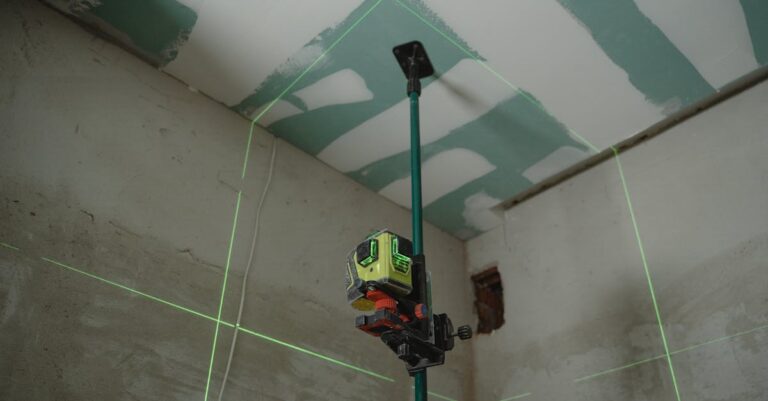Installing new sod is like throwing a housewarming party for your lawn. Everyone’s excited, but if you don’t give it the right attention, things could go south faster than a party crasher at a wedding. Watering is the secret sauce to keeping that fresh sod lush and vibrant. But how often should it be watered?
Table of Contents
ToggleImportance Of Proper Watering For Sod
Proper watering post-installation significantly affects sod health. Maintaining adequate moisture levels promotes strong root development and overall lawn resilience.
Benefits Of Adequate Moisture
Adequate moisture ensures sod roots establish quickly, leading to a lush and green lawn. Watering consistently supports nutrient absorption, allowing the grass to thrive. Well-hydrated sod resists pests and diseases more effectively, enhancing its longevity. Healthy sod also withstands environmental stressors like heat and drought, ensuring a vibrant landscape.
Consequences Of Overwatering Or Underwatering
Overwatering sod can suffocate roots, leading to disease and weak grass. Excess moisture encourages mold growth and waterlogged soil, hindering proper nutrient uptake. Underwatering, on the other hand, results in dry, patchy areas that struggle to thrive. Insufficient hydration leads to shallow root systems, making sod vulnerable to stress. Both extremes negatively impact the lawn’s appearance and health, emphasizing the need for balanced watering practices.
Factors Influencing Watering Frequency
Numerous factors impact how often sod needs watering after installation. Understanding these elements ensures proper care and optimal growth.
Climate Conditions
Temperature and humidity levels dictate watering frequency. Warmer climates require more water, especially during dry spells. In contrast, cooler, more humid conditions may reduce the need for frequent watering. Rainfall also plays a role; if recent rains occurred, less supplemental watering is necessary. Generally, the hotter the climate, the more attention the sod needs regarding moisture levels.
Type Of Soil
Soil composition affects how moisture is retained. Sandy soil drains quickly, demanding more frequent watering to keep sod hydrated. Conversely, clay soil retains water for longer periods, potentially leading to overwatering challenges if not monitored. Loamy soil strikes a balance, holding moisture while promoting drainage. Each soil type necessitates a tailored watering schedule to ensure robust growth.
Type Of Grass
Different grass varieties require varying amounts of water. Cool-season grasses thrive in cooler temperatures and typically need less water during their active growing periods. Warm-season grasses, on the other hand, flourish in heat, often requiring more frequent watering. Additionally, certain grass types possess drought-resistant properties, minimizing their need for regular irrigation. Selecting the right grass type influences overall watering needs substantially.
Recommended Watering Schedule After Installation
Watering frequency plays a critical role in helping newly installed sod establish itself. Following a consistent watering schedule promotes healthy growth and strengthens roots.
First Few Days
During the first few days post-installation, sod requires ample moisture. Watering should occur 2 to 4 times daily for short durations, ensuring the surface of the sod remains consistently damp. Morning and late afternoon sessions work best, avoiding peak sunlight hours to reduce evaporation. Checking soil moisture helps gauge whether more water is necessary as initial establishment often affects watering needs.
Weeks Following Installation
After the initial period, the watering regimen should shift to once per day or every other day. This frequency allows the roots to deepen while preventing waterlogging. Each session should deliver 1 to 1.5 inches of water, encouraging strong root systems. Gradually spacing out watering encourages sod to acclimate and thrive. Observing the sod for signs of distress, like wilting, will help fine-tune the schedule based on prevailing climate conditions.
Signs Of Overwatering And Underwatering
Recognizing signs of overwatering and underwatering helps maintain healthy sod. Observing symptoms allows for timely adjustments in watering practices.
Identifying Overwatered Sod
Yellowing leaves often indicate overwatering. Additionally, grass may feel spongy underfoot. Mold or fungus, such as mushrooms, can emerge in consistently damp areas. Root development slows, leading to shallow roots. Puddles forming on the surface signal excess water. Diagnostic tools, such as moisture meters, can help assess soil conditions accurately.
Recognizing Underwatered Sod
Brown patches frequently characterize underwatered sod. Leaves may curl or become crispy, losing their lush appearance. Roots struggle to establish due to insufficient moisture. Additionally, the lawn may feel dry and brittle underfoot. Weeds often proliferate, thriving in neglected areas. Regular inspection allows for prompt interventions, ensuring that the sod receives the right amount of water.
Establishing a healthy lawn after sod installation hinges on effective watering practices. By understanding the specific needs of the sod based on climate, soil type, and grass variety, homeowners can create a tailored watering schedule. Regular monitoring for signs of distress ensures adjustments can be made promptly. With the right balance of moisture, sod can thrive, leading to a vibrant and resilient lawn that enhances any outdoor space. Prioritizing proper care during this critical period sets the foundation for long-term success.



